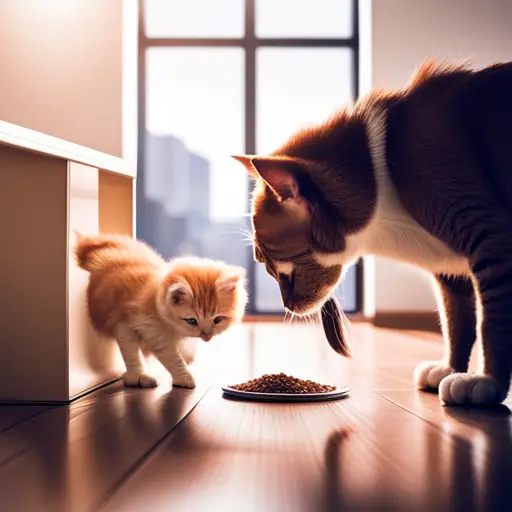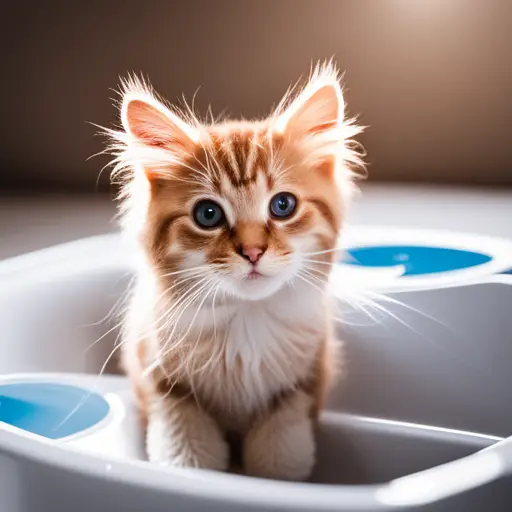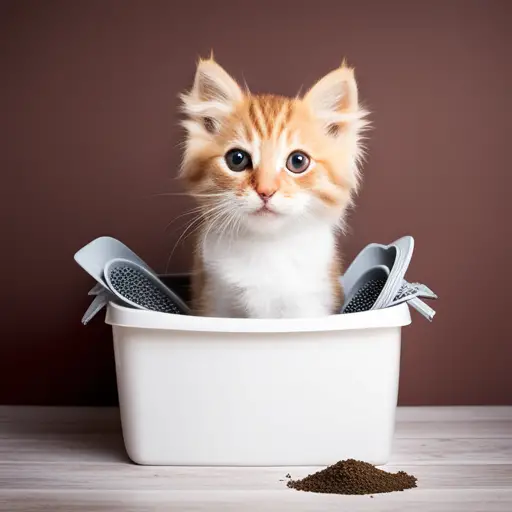Are you a proud new kitten owner who wants to ensure your furry friend is well-trained and happy? One of the most important aspects of kitten training is litter box training. But how do you go about it? Don’t worry, this ultimate guide to litter box training your kitten has got you covered.
Choosing the right litter box is the first step towards successful litter box training. There are a variety of litter box types and sizes to choose from, and it’s important to find the right one for your kitten’s needs.
This guide will walk you through the process of introducing your kitten to the litter box and troubleshooting common problems that may arise. With our expert tips and tricks, you’ll be able to maintain a clean litter box and even learn advanced training techniques to take your kitten’s training to the next level.
Let’s get started!
Key Takeaways
– Choosing the right litter box is crucial for successful litter box training.
– Regular scooping and cleaning of the litter box are important for the kitten’s health and comfort.
– Proper odor control techniques and litter replacement schedules should be established.
– Consistency, patience, and positive reinforcement are key to achieving confident and consistent litter box use in your kitten.
Choosing the Right Litter Box

Looking for the purr-fect litter box for your new fur baby? Here’s how to choose the right one!
When it comes to selecting a litter box for your kitten, there are a few size considerations to keep in mind. First, make sure the box is big enough for your kitten to comfortably move around in. A good rule of thumb is to choose a box that is at least one and a half times the length of your kitten. This will give them enough space to turn around and dig comfortably.
Next, consider the material options. Litter boxes come in a variety of materials, including plastic, metal, and even natural fibers. Plastic is the most common and affordable option, but it can sometimes retain odors and scratches easily. Metal boxes are durable and easy to clean, but they can be noisy and cold to the touch. Natural fiber boxes are eco-friendly and biodegradable, but they may not be as durable as plastic or metal options.
Ultimately, the material you choose will depend on your personal preferences and your kitten’s needs.
Introducing Your Kitten to the Litter Box

When you bring your new furry friend home, show them the cozy little spot you’ve prepared for them, where they can take care of their business in peace. Your kitten may not be familiar with using a litter box, so it’s important to introduce them to it in a positive way.
Place your kitten in the litter box and let them explore. You can also gently take their paws and show them how to dig in the litter. Praise them with a treat or verbal encouragement when they use the litter box correctly.
Kitten behavior can be unpredictable, so it’s important to be patient and use positive reinforcement. If your kitten has an accident outside the litter box, clean it up without scolding them. Instead, gently place them in the litter box and encourage them to use it.
With consistency and patience, your kitten will learn to use the litter box and enjoy their cozy little spot. Remember to keep the litter box clean and accessible at all times to encourage proper use.
Troubleshooting Common Litter Box Training Problems

Having trouble getting your furry friend to use their designated spot for doing their business? Here are some common issues you may encounter during litter box training and how to solve them. One of the most common problems is anxiety. If your kitten is anxious, they may not want to use the litter box, or they may start going outside of it. To combat this, make sure the litter box is in a calm, quiet area of the house where your kitten feels safe. You can also try using a calming spray or diffuser to help your kitten feel more relaxed.
Another issue you may face is your kitten not responding to negative reinforcement. Instead of punishing your kitten for not using the litter box, try using positive reinforcement. Reward your kitten with treats or praise when they use the litter box correctly. It’s also important to clean the litter box regularly, as cats are very clean animals and may not want to use a dirty litter box. By using positive reinforcement and keeping the litter box clean, you can help your kitten form good habits and become a pro at using their designated spot for doing their business.
| Common Litter Box Training Problems | Solutions |
|---|---|
| Anxiety | Keep the litter box in a calm, quiet area of the house and use a calming spray or diffuser. |
| Not responding to negative reinforcement | Use positive reinforcement, such as treats or praise, and make sure to clean the litter box regularly. |
| Not using a dirty litter box | Clean the litter box regularly to ensure your kitten has a clean and comfortable place to go. |
Maintaining a Clean Litter Box

To maintain a clean litter box, you’ll need to scoop and clean it regularly. This means removing waste and any clumps of litter on a daily basis.
You’ll also need to change the litter completely every 2-3 weeks to keep the box fresh and hygienic.
And don’t forget about odor control – using a litter deodorizer or baking soda can help keep unpleasant smells at bay.
Scooping and Cleaning
Maintaining a clean litter box is crucial in ensuring your kitten’s hygiene and comfort, so it’s important to scoop out any clumps or waste regularly. A dirty litter box not only makes your kitten uncomfortable, but it can also lead to the spread of bacteria and illnesses. To keep your kitten healthy and happy, scoop out any waste at least once a day and completely replace the litter every two to three weeks.
When scooping out waste, make sure to use a scooper specifically designed for litter boxes. This will make the process easier and more efficient. You should also properly dispose of the waste by placing it in a sealed bag and throwing it away in an outdoor trash bin. Additionally, regularly cleaning the litter box with soap and water will help maintain its hygiene and prevent any unpleasant odors. By following these simple steps, you can ensure that your kitten’s litter box is always clean and comfortable.
| Dos | Don’ts |
|---|---|
| Use a litter box liner | Use harsh chemicals to clean the litter box |
| Scoop out waste daily | Wait too long to replace the litter |
| Completely replace litter every 2-3 weeks | Overfill the litter box with litter |
| Properly dispose of waste | Let the litter box get too full before scooping |
| Clean litter box with soap and water | Use a scooper not designed for litter boxes |
Remember, your kitten depends on you for its well-being, and maintaining a clean litter box is just one way to ensure its health and comfort. By following the dos and avoiding the don’ts listed in the table above, you can make litter box training a breeze and keep your kitten happy and healthy.
Changing the Litter
When it’s time to switch out the old litter, you’ll be glad to know that it’s a simple and quick process. First, you’ll need to decide on the type of litter to use. There are many options available, including clay, silica gel crystals, recycled paper, and even natural wood pellets. Each type has its own benefits and drawbacks, so it’s important to do your research and choose the one that best fits your needs and preferences.
Once you’ve selected your litter, it’s important to establish a regular schedule for changing it. Generally, it’s recommended to change the litter every two to three days. However, if you have multiple cats or your kitten is particularly messy, you may need to change it more frequently.
Regular litter changes not only keep your home smelling fresh, but also help prevent the spread of bacteria and disease. By following these simple steps, you can ensure that your kitten’s litter box stays clean and comfortable, making both you and your furry friend happy.
Odor Control
Keeping your kitten’s litter box smelling fresh can be achieved with proper odor control techniques. One of the most important things you can do is to choose the right location for the litter box. Keep it in a well-ventilated area away from high traffic areas in your home. Also, make sure it’s not too close to your kitten’s food and water bowls.
Preventing tracking is also key to controlling litter box odor. Invest in a litter mat that can catch any litter that gets stuck to your kitten’s paws. You can also try a litter box with a lid to keep litter from spilling out onto the floor.
Finally, make sure to scoop the litter box at least once a day and change the litter entirely every week. With these tips, you’ll be able to keep your kitten’s litter box smelling fresh and clean.
Advanced Litter Box Training Techniques

Now that you’ve mastered the basics of litter box training, it’s time to move on to advanced techniques.
One important skill to teach your kitten is covering their waste. This helps keep the litter box odor-free and encourages good hygiene habits.
You can also encourage consistency in your kitten’s litter box habits by sticking to a regular cleaning schedule.
Finally, gradually giving your kitten more independence with their litter box can help them feel more comfortable and confident using it.
Teaching to Cover Waste
To get your kitten in the habit of covering their waste, you’ll want to gently take their paw and show them how to scrape the litter over their mess. This may seem tedious, but it’ll pay off in the long run.
Positive reinforcement is key in this process. Whenever your kitten covers their waste, praise them and give them a treat. This’ll encourage them to continue the behavior.
Another tip is to use litter box liners. These make cleaning up easier and more efficient. They also make it easier for your kitten to cover their waste. The litter will stay in place, making it easier for them to scrape it over their mess.
By following these tips, your kitten will soon be a pro at covering their waste, making for a much cleaner and more pleasant litter box experience for both you and your furry friend.
Encouraging Consistency
If you want your furry friend to consistently use their litter box, it’s important to establish a routine and stick to it. This means feeding them at the same time every day, placing their litter box in the same location, and cleaning it on a regular basis.
Consistency is key when it comes to litter box training, as it helps your kitten develop good habits and reinforces the idea that the litter box is the only place to go potty.
In addition to establishing routine, positive reinforcement is also important in encouraging consistency. When your kitten uses the litter box, praise them and offer a small treat as a reward. This will help them associate the litter box with positive experiences and encourage them to use it again in the future.
Avoid punishing your kitten for accidents outside of the litter box, as this can create fear and anxiety around using it. Instead, focus on rewarding good behavior and being patient as your kitten learns.
With time and patience, your furry friend will become a litter box pro in no time!
Gradual Independence
As your furry friend grows, they’ll naturally begin to assert their independence and explore their surroundings. This is the perfect time to teach them boundaries and gradually give them more freedom.
Start by expanding their play area and introducing them to new toys and objects to explore. However, it’s important to remember that litter box training is a process that requires patience and consistency.
Gradually introduce your kitten to their litter box and reward them for using it. As they become more independent, give them the freedom to explore on their own, but always keep an eye on them to ensure they’re using their litter box properly.
With time and patience, your kitten will learn to use their litter box consistently and confidently.
Conclusion
Congratulations on successfully litter box training your kitten! With patience, consistency, and the right tools, you were able to teach your furry friend this important skill.
Remember to always choose the right litter box for your cat’s size and needs, and to introduce them to it slowly and positively.
If you encounter any problems along the way, don’t give up! Troubleshoot common issues like litter box aversion or inappropriate elimination by adjusting the litter type or box location.
And don’t forget to maintain a clean litter box to keep your kitten happy and healthy.
As your kitten grows and becomes more comfortable with using the litter box, consider advanced training techniques like teaching them to use the toilet or a self-cleaning litter box.
With your dedication and love, your kitten will continue to thrive and grow into a happy, healthy, and well-trained cat.
